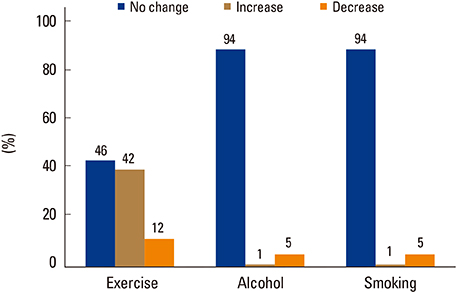J Bone Metab.
2018 May;25(2):115-121. 10.11005/jbm.2018.25.2.115.
The Impact of Educational Interventions on Osteoporosis Knowledge among Korean Osteoporosis Patients
- Affiliations
-
- 1Department of Internal Medicine, Wonkwang University Sanbon Hospital, Gunpo, Korea. hykimmd@hanmail.net
- 2Department of Internal Medicine, School of Medicine, Kangwon National University, Chuncheon, Korea.
- 3Department of Orthopaedic Surgery, SM Christianity Hospital, Pohang, Korea.
- 4Department of Orthopedic Surgery, Sungmin General Hospital, Incheon, Korea.
- 5Department of Orthopaedic Surgery, Chung-Ang University College of Medicine, Seoul, Korea.
- 6College of Pharmacy and Gachon Institute of Pharmaceutical Sciences, Gachon University, Incheon, Korea.
- KMID: 2413373
- DOI: http://doi.org/10.11005/jbm.2018.25.2.115
Abstract
- BACKGROUND
The purpose of this study was to determine the impact of an educational intervention that includes information sharing about absolute fracture risk on the knowledge of osteoporosis and modifiable risk factors among Korean patients with osteoporosis.
METHODS
Adults aged >50 years who visited the outpatient clinic for osteoporosis were recruited. Subjects with trauma-related fractures or pathological fractures were excluded. The anthropometric data and clinical risk factors for fracture were collected at baseline. The participants completed the survey questionnaire that measured their knowledge regarding osteoporosis at baseline and then received information about the risk of fracture and individual education. Fracture risk was classified into five groups according to degree. The post-survey was conducted 3 months later. The pretest results were compared with the posttest results.
RESULTS
In this study, 179 subjects (15 men and 164 women) were enrolled. After the educational intervention, the mean osteoporosis knowledge score significantly increased from 10.6±5.7 at pre-education (baseline) to 11.7±6.3 at post-education (P < 0.001). When comparing the pre- and post-education Korean fracture risk scores, a negligible difference was found between the "very low risk" and "low risk" groups. However, the scores in the "very high risk" and "high risk" groups decreased from 77.6% to 76.0%. We found a difference over time only in physical activity.
CONCLUSIONS
Simple educational intervention is effective in increasing osteoporosis knowledge among Korean patients with osteoporosis. It may confer some benefit by providing information about osteoporotic fracture risks to improve knowledge and awareness regarding osteoporosis.
MeSH Terms
Figure
Reference
-
1. Lee SR, Ha YC, Kang H, et al. Morbidity and mortality in Jeju residents over 50-years of age with hip fracture with mean 6-year follow-up: a prospective cohort study. J Korean Med Sci. 2013; 28:1089–1094.
Article2. Winzenberg TM, Oldenburg B, Frendin S, et al. Effects of bone density feedback and group education on osteoporosis knowledge and osteoporosis self-efficacy in premenopausal women: a randomized controlled trial. J Clin Densitom. 2005; 8:95–103.
Article3. Brecher LS, Pomerantz SC, Snyder BA, et al. Osteoporosis prevention project: a model multidisciplinary educational intervention. J Am Osteopath Assoc. 2002; 102:327–335.4. Laslett LL, Lynch J, Sullivan TR, et al. Osteoporosis education improves osteoporosis knowledge and dietary calcium: comparison of a 4 week and a one-session education course. Int J Rheum Dis. 2011; 14:239–247.
Article5. Kim HY, Jang EJ, Park B, et al. Development of a Korean fracture risk score (KFRS) for predicting osteoporotic fracture risk: Analysis of data from the Korean national health insurance service. PLoS One. 2016; 11:e0158918.
Article6. Winzenberg TM, Oldenburg B, Frendin S, et al. The design of a valid and reliable questionnaire to measure osteoporosis knowledge in women: the Osteoporosis Knowledge Assessment Tool (OKAT). BMC Musculoskelet Disord. 2003; 4:17.
Article7. Choi YJ, Oh HJ, Kim DJ, et al. The prevalence of osteoporosis in Korean adults aged 50 years or older and the higher diagnosis rates in women who were beneficiaries of a national screening program: the Korea National Health and Nutrition Examination Survey 2008–2009. J Bone Miner Res. 2012; 27:1879–1886.
Article8. Francis KL, Matthews BL, Van Mechelen W, et al. Effectiveness of a community-based osteoporosis education and self-management course: a wait list controlled trial. Osteoporos Int. 2009; 20:1563–1570.
Article9. Kulp JL, Rane S, Bachmann G. Impact of preventive osteoporosis education on patient behavior: immediate and 3-month follow-up. Menopause. 2004; 11:116–119.
Article10. Evenson AL, Sanders GF. Educational intervention impact on osteoporosis knowledge, health beliefs, self-efficacy, dietary calcium, and vitamin D intakes in young adults. Orthop Nurs. 2016; 35:30–36. quiz 7-8.
Article11. Beaudoin C, Bessette L, Jean S, et al. The impact of educational interventions on modifiable risk factors for osteoporosis after a fragility fracture. Osteoporos Int. 2014; 25:1821–1830.
Article12. Tanner EK. Chronic illness demands for self-management in older adults. Geriatr Nurs. 2004; 25:313–317.
Article13. Kasper MJ, Peterson MG, Allegrante JP. The need for comprehensive educational osteoporosis prevention programs for young women: results from a second osteoporosis prevention survey. Arthritis Rheum. 2001; 45:28–34.
Article14. Izuora KE, Alazraki N, Byrd-Sellers J, et al. Fracture assessment tool risk scores in bone density reports do not change physician prescribing behavior for osteoporosis. Am J Med Sci. 2011; 342:5–8.
Article15. Winzenberg T, Oldenburg B, Frendin S, et al. The effect on behavior and bone mineral density of individualized bone mineral density feedback and educational interventions in premenopausal women: a randomized controlled trial [NCT00273260]. BMC Public Health. 2006; 6:12.
Article16. Guilera M, Fuentes M, Grifols M, et al. Does an educational leaflet improve self-reported adherence to therapy in osteoporosis? The OPTIMA study. Osteoporos Int. 2006; 17:664–671.
Article17. Solomon DH, Finkelstein JS, Polinski JM, et al. A randomized controlled trial of mailed osteoporosis education to older adults. Osteoporos Int. 2006; 17:760–767.
Article18. Piaseu N, Schepp K, Belza B. Causal analysis of exercise and calcium intake behaviors for osteoporosis prevention among young women in Thailand. Health Care Women Int. 2002; 23:364–376.
Article
- Full Text Links
- Actions
-
Cited
- CITED
-
- Close
- Share
- Similar articles
-
- Knowledge on Osteoporosis among Nurses
- Osteoporosis knowledge assessment and osteoporosis education recommendations in the health professions
- A Study on the Relationships between Knowledge about Osteoporosis and Cognitive Factors in Middle-aged Women
- Knowledge on Osteoporosis of Prescriber According to Level of Medical Institute
- Causes, diagnosis, and treatment of pediatric osteoporosis



